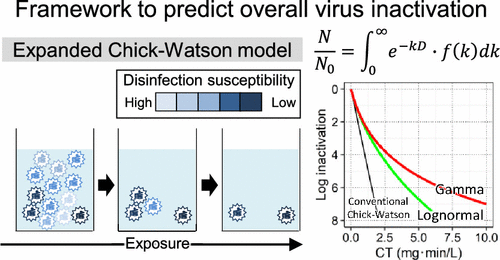当前位置:
X-MOL 学术
›
Environ. Sci. Technol.
›
论文详情
Our official English website, www.x-mol.net, welcomes your
feedback! (Note: you will need to create a separate account there.)
Impact of the Heterogeneity in Free Chlorine, UV254, and Ozone Susceptibilities Among Coxsackievirus B5 on the Prediction of the Overall Inactivation Efficiency
Environmental Science & Technology ( IF 10.8 ) Pub Date : 2021-02-15 , DOI: 10.1021/acs.est.0c07796 Shotaro Torii 1 , Fuminari Miura 2 , Masae Itamochi 3 , Kei Haga 4 , Kazuhiko Katayama 4 , Hiroyuki Katayama 1
Environmental Science & Technology ( IF 10.8 ) Pub Date : 2021-02-15 , DOI: 10.1021/acs.est.0c07796 Shotaro Torii 1 , Fuminari Miura 2 , Masae Itamochi 3 , Kei Haga 4 , Kazuhiko Katayama 4 , Hiroyuki Katayama 1
Affiliation

|
The disinfection susceptibilities of viruses vary even among variants, yet the inactivation efficiency of a certain virus genotype, species, or genus was determined based on the susceptibility of its laboratory strain. The objectives were to evaluate the variability in susceptibilities to free chlorine, UV254, and ozone among 13 variants of coxsackievirus B5 (CVB5) and develop the model allowing for predicting the overall inactivation of heterogeneous CVB5. Our results showed that the susceptibilities differed by up to 3.4-fold, 1.3-fold, and 1.8-fold in free chlorine, UV254, and ozone, respectively. CVB5 in genogroup B exhibited significantly lower susceptibility to free chlorine and ozone than genogroup A, where the laboratory strain, Faulkner, belongs. The capsid protein in genogroup B contained a lower number of sulfur-containing amino acids, readily reactive to oxidants. We reformulated the Chick–Watson model by incorporating the probability distributions of inactivation rate constants to capture the heterogeneity. This expanded Chick–Watson model indicated that up to 4.2-fold larger free chlorine CT is required to achieve 6-log inactivation of CVB5 than the prediction by the Faulkner strain. Therefore, it is recommended to incorporate the variation in disinfection susceptibilities for predicting the overall inactivation of a certain type of viruses.
中文翻译:

柯萨奇病毒B5中游离氯,UV 254和臭氧敏感性的异质性对总体灭活效率预测的影响
病毒的消毒敏感性甚至在变体之间也有所不同,但是根据其实验室菌株的敏感性来确定某些病毒基因型,种类或属的灭活效率。目的是评估柯萨奇病毒B5(CVB5)的13个变体中对游离氯,UV 254和臭氧的敏感性变化,并开发模型以预测异源CVB5的总体失活。我们的结果表明,在游离氯,UV 254中,磁化率相差高达3.4倍,1.3倍和1.8倍。和臭氧。与实验室菌株福克纳所属的基因组A相比,基因组B中的CVB5对游离氯和臭氧的敏感性要低得多。基因组B中的衣壳蛋白含有较少数量的含硫氨基酸,易于与氧化剂反应。我们通过合并失活速率常数的概率分布来捕获异质性,从而重新构造了Chick-Watson模型。这种扩展的Chick-Watson模型表明,要实现CVB5的6对数失活,需要比Faulkner菌株预测的多多达4.2倍的游离氯CT。因此,建议结合消毒敏感性的变化来预测某种类型病毒的总体灭活。
更新日期:2021-03-02
中文翻译:

柯萨奇病毒B5中游离氯,UV 254和臭氧敏感性的异质性对总体灭活效率预测的影响
病毒的消毒敏感性甚至在变体之间也有所不同,但是根据其实验室菌株的敏感性来确定某些病毒基因型,种类或属的灭活效率。目的是评估柯萨奇病毒B5(CVB5)的13个变体中对游离氯,UV 254和臭氧的敏感性变化,并开发模型以预测异源CVB5的总体失活。我们的结果表明,在游离氯,UV 254中,磁化率相差高达3.4倍,1.3倍和1.8倍。和臭氧。与实验室菌株福克纳所属的基因组A相比,基因组B中的CVB5对游离氯和臭氧的敏感性要低得多。基因组B中的衣壳蛋白含有较少数量的含硫氨基酸,易于与氧化剂反应。我们通过合并失活速率常数的概率分布来捕获异质性,从而重新构造了Chick-Watson模型。这种扩展的Chick-Watson模型表明,要实现CVB5的6对数失活,需要比Faulkner菌株预测的多多达4.2倍的游离氯CT。因此,建议结合消毒敏感性的变化来预测某种类型病毒的总体灭活。











































 京公网安备 11010802027423号
京公网安备 11010802027423号